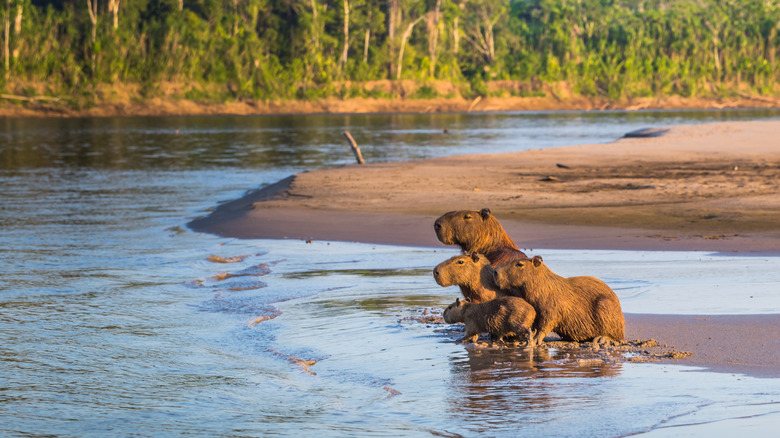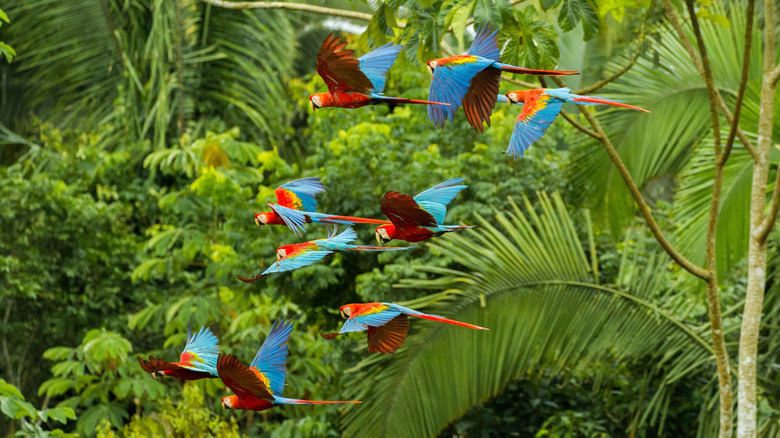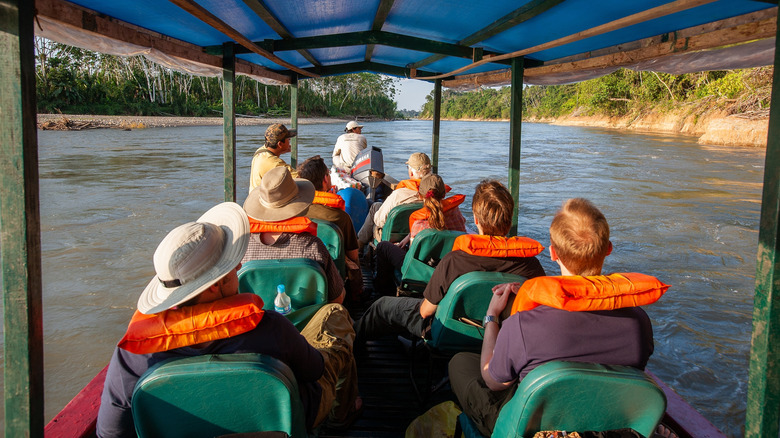South America's Best-Kept Secret For Eco-Adventurers Is One Of The World's Most Biodiverse National Parks
Deep in the southeast of Peru lies one of the most biodiverse places on Earth: Manu National Park. A UNESCO World Heritage Site, Manu stretches over 1.7 million hectares, from the high Andean plains down to the lowland Amazon basin. Visiting Manu is a once-in-a-lifetime experience for travelers who crave raw, immersive encounters with nature.
Manu's varied elevational range — from 1,000 to over 14,000 feet — gives rise to a mosaic of ecosystems, each hosting its own unique group of species. You might hear red howler monkeys roaring from up to three miles away or catch sight of a troop of spider monkeys leaping through the canopy. Capybaras graze along riverbanks. Tapirs, caimans, and anacondas haunt the forest edges, while harpy eagles soar over their heads. Keep your eyes peeled for the cock-of-the-rock, Peru's national bird, or perhaps the elusive spectacled bear. And if you're lucky, you might glimpse a jaguar basking in the sun, the park's most majestic resident.
Manu is not for the faint of heart. Unlike more accessible destinations in Peru, like Machu Picchu or the Sacred Valley, it is a journey for the most intrepid. Touch the wrong tree, and fire ants will come in a stampede after you. Take a wrong turn, and you're lost among venomous plants and animals. But with the right tour guide, you'll get the chance to safely witness life in its most untamed and abundant. "Manú is one of the few places in the tropics where there is an opportunity to experience ... biodiversity in its full glory," ecologist Kent Redford told National Geographic.
See species you haven't even heard of at Manu
If you follow wildlife news, you've probably seen headlines about new species discovered at Manu. It's no surprise then that the park is home to the highest diversity of reptiles and amphibians of any protected area, over 1,300 butterfly species, and more than 1,000 bird species (nearly 10% of the world's total). No tour to the park skips the clay licks or "collpas" where hundreds of colorful parrots and macaws gather at dawn to feed on mineral-rich soil. There are even tours exclusively for birdwatching.
Beyond its natural wonders, Manu is also home to indigenous communities such as the Matsigenka, Yine, and Harakmbut peoples. Large parts of the park are off-limits to visitors to protect fragile ecosystems and communities, but several tours include visits to the cultural zone without compromising their integrity. Here, travelers can gain insight into traditional knowledge, sustainable practices, and the spiritual connection between the indigenous people and their environment — all while contributing directly to the local economy.
Needless to say, don't try to go to Manu on your own. Even experienced survivalists need guidance from experts who know this region intimately. Tours last from four to ten days and cost from $300 to around $2,000 per person. This typically includes lodging, a bilingual guide, all meals, and ground and river transportation. They can also include guided night walks to look for nocturnal animals, such as huntsman spiders (Sparassidae), some of the 92 species of bats, or several species of crystal frogs — the ones with translucent skin that reveal their inner organs!
More lodging and safety tips for Manu National Park
The odyssey to reach Manu is part of its magic. You'll first have to fly to Cusco city's Alejandro Velasco Astete International Airport, which means catching a connecting flight (about 90 minutes direct) from Lima's Jorge Chávez International Airport. From Cusco you'll either take your tour's bus (12 hours), or hop on another 90-minute flight to Puerto Maldonado International Airport (and then a 2-hour bus), to then take a boat into Manu National Park — like many other tourist hotspots in the Amazon, Manu is not accessible by land. We strongly recommend spending at least a day in Cusco, a wildly affordable city that breathes history in every corner. It was the capital of the Inca Empire, after all.
The best time to visit is during the dry season, from May to October, when trails are passable and wildlife viewing is easier. However, some tour operators offer discounted rates during rainy season. Keep in mind that there are no hotels in Manu, only eco-lodges and research stations that host tourists and volunteers alike, like Manu Biological Station.
Finally, we recommend being up to date on vaccines for yellow fever, typhoid, hepatitis A and B, and rabies. For protection from mosquito-borne threats, use EPA-approved repellents and consider antimalarial medication, with regimens like atovaquone–proguanil or doxycycline prescribed before, during, and after your visit. Experts recommend kitting your backpack with a fleece or thermal jacket, long-sleeve lightweight hiking pants and shirts (water-repellant), a refillable water bottle, sunscreen, a flashlight or headlamp, bug repellent, a swimsuit and towel, and waterproof hiking boots and sandals. Finally, stick to bottled or properly filtered water, avoid consumption of raw food, and seek medical attention promptly for fevers during or up to several weeks post-trip.


